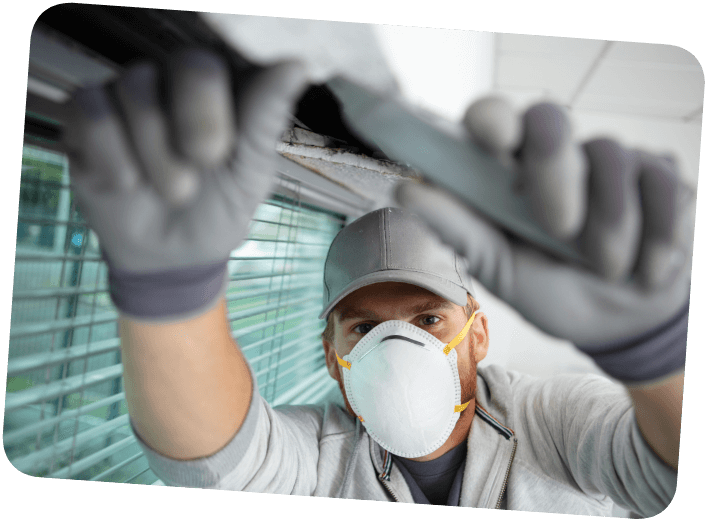
Building Safety
Asbestos

How we manage asbestos across our properties.
Asbestos is the name given to a group of silicate minerals commonly found in rocks worldwide (though not in the UK).
The three most common forms of asbestos are:
- crocidolite ('blue asbestos')
- amosite ('brown asbestos')
- chrysotile ('white asbestos')
Asbestos fibres are flexible and mechanically strong, have high tensile strength and are chemical, electrical and heat resistant. Asbestos was commonly used raw (eg textiles and insulation) or combined with other materials (eg boards, asbestos cement).
Asbestos was banned in the UK in 1999. However, a lot of our housing was built or refurbished before this time and some properties contain asbestos materials. Products containing asbestos can look the same as those that do not, so you should always be careful.
Our asbestos policy
It is our policy, in line with Legislation and the Health and Safety Executive’s (HSE) Guidance, to leave asbestos-containing materials that are in good condition in place.
However, if an asbestos-containing material is in poor condition, is likely to be disturbed resulting in damage, or if a repair, improvement or alteration takes place on or near it, we will remove it.
The important thing to remember is that as long as asbestos-containing materials are in good condition they do not pose a risk.
Where could asbestos be in my home?
Outside your home
- Roof tiles, promenade tiles and cladding tiles
- flue pipes, guttering and rainwater pipes, soffit and fascia boards and window boxes
- corrugated cement garage and shed roofs
- sprayed coatings to garage ceilings (Thamesmead estate)
- string to pipe insulation, external pipework boxing (Thamesmead estate)
Inside your home
- Textured coatings to ceilings and walls (sometimes known as "Artex")
- floor tiles and/or tile adhesive
- panels above doors, access panels and linings to service ducts, cupboards, doors, loft access hatches to walls behind or above radiators and beneath stairs
- pipe insulation and pipe gaskets
- bath panels and older toilet cisterns
- sink pads
- window sills
- older domestic boilers and electric storage heaters
- water tanks
- asbestos mastic and glazing joints to windows and doors
- 'Belgium board' composite asbestos/wood/asbestos internal wall panels (Thamesmead estate)
- asbestos boards with melamine type decorative finish (Thamesmead estate)
- older electrical fuse boards and equipment may contain asbestos flashguards, rope seals or phase barriers
- Ironing board mats
Asbestos: what are the risks?
Asbestos-containing materials are not a risk if they are in good condition. If they do become damaged or their condition deteriorates, then you and others may be at risk. Damaged asbestos containing materials can release fibres which, when inhaled, can cause serious diseases.
We have a duty to manage materials containing asbestos in our properties. We do this by:
- Developing an Asbestos Management Plan setting out how we will manage asbestos in our properties.
- Carrying out surveys of individual properties, locations and communal areas.
- Recording all asbestos information on our asbestos register.
- Providing information about the presence of asbestos-containing materials to anyone who could potentially come into contact with them.
- Employing accredited asbestos survey consultants and licensed asbestos removal contractors for all work involving asbestos-containing materials.
Advice for tenants - do's and don'ts
Contact us straightaway if:
- You have any concerns about asbestos containing materials in your property.
- Any materials you think may contain asbestos or have been told contain asbestos have become damaged or disturbed.
Make sure that:
- Any material you have been told contains asbestos stays in good condition.
- Before you carry out any DIY work you should get our advice. You may also need permission under the conditions of your tenancy. Remember, materials that contain asbestos which are in good condition are not a risk to your health.
Make sure you don’t:
- Work on, damage or remove materials containing asbestos, including drilling, cutting, scraping or sanding.
- Jet-wash or clean down asbestos cement roofing materials such as corrugated garage or shed roofs.
- Remove old floor tiles or linoleum which could contain asbestos.
Removing domestic appliances that may contain asbestos
Items such as cookers, ironing board pads, fire blankets and oven gloves may contain asbestos. If you are planning to dispose of any of these items and think they may contain asbestos, please contact your local authority first for advice. These items are not Town & Country Housing's responsibility to remove.
Leaseholders' responsibility
Under the terms of your lease, leaseholders (homeowners) or freeholders are responsible for all fixtures and fittings within the property, which includes textured coatings such as 'Artex' and floor tiles.
We are responsible for the structure of the building and communal areas. It is best to leave any items you think contain asbestos in place if they are in good condition. For example, if you wish to lay carpet on top of floor tiles, use tape to hold the carpet down instead of a carpet gripper rod, as this will damage the floor tiles beneath.
If you would like to remove materials that contain asbestos, we recommend that you contact an asbestos-removal contractor licensed by the Health and Safety Executive (HSE) to carry out the work.
If you do remove asbestos as described, please tell us so we can keep a record and pass on any relevant information to new residents, contractors and third parties.
Find out more
For further information, help or advice relating to asbestos please contact us.
Additional advice can obtained from your local authority or from: Health and Safety Executive, telephone: 0845 345 0055 or visit The Environment Agency, telephone 08708 506 506
